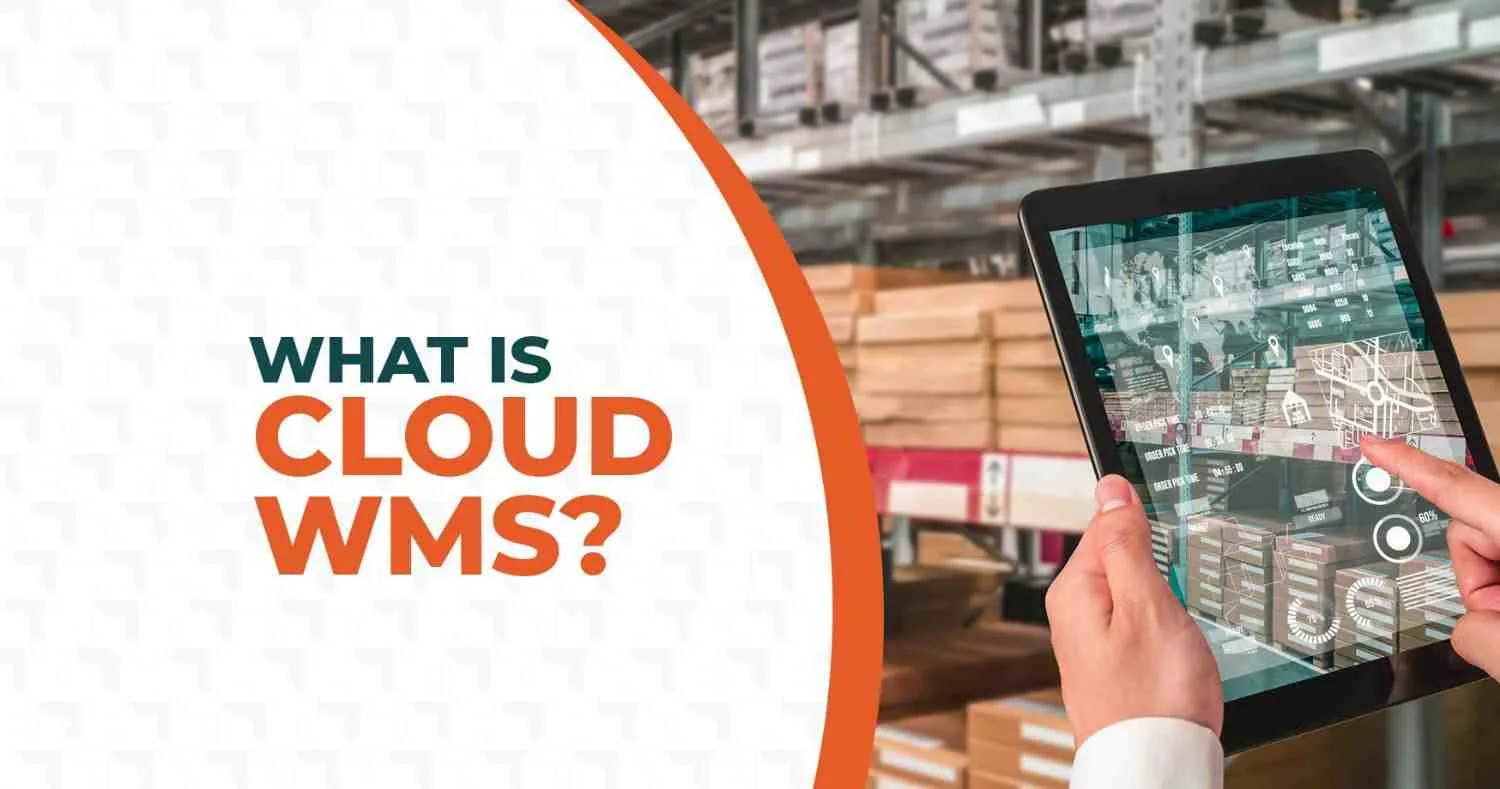
Cloud Warehouse Management System
A Cloud Warehouse Management System (Cloud WMS) is a digital supply chain solution that helps businesses manage and optimize their warehouse operations using cloud technology. They are hosted on remote servers and accessed via the internet. This modern approach offers scalability, real-time data access, and lower upfront costs, making it particularly appealing to businesses seeking to optimize their supply chains without incurring major IT investments.
Read this blog to further understand why cloud-based warehouse management setup is a preferred choice for businesses and why they shifted away from traditional on-premise methods.
Why is Industry Shifting Towards Cloud WMS?
The shift towards Cloud Warehouse Management Systems (Cloud WMS) is a response to the real limitations of traditional systems and the changing needs of modern supply chains. The cloud WMS offers a smarter, leaner alternative. The kind that supports both day-to-day efficiency and long-term growth. Let’s break down the key reasons driving this industry-wide transition:
1. Limitations of Traditional WMS
On-premise systems are expensive to set up and scale. Adding new warehouses or managing demand spikes means more hardware and longer lead times. Updates are manual, often causing downtime and increasing pressure on IT teams. These rigid systems simply can’t match the pace of today’s business needs.
2. Demand for Real-Time Control and Visibility
Modern warehousing needs live data, not delayed reports. Cloud WMS offers real-time dashboards, alerts, and mobile access. This helps teams respond instantly, reduce delays, and make data-backed decisions with ease.
3. Need for Agility and Remote Access Post-Pandemic
The pandemic proved the value of remote access. Cloud WMS allows teams to manage operations from anywhere, with centralized data and flexible workflows. It’s built for a world where unpredictability is the norm and adaptability is the need of the hour.
Key Features of BCI Cloud WMS
Cloud-based Warehouse Management Systems are built to simplify, speed up, and optimize warehouse operations from the ground up. These systems have the ability to bring agility and intelligence to everyday workflows. Here's a look at their most impactful features:
Real-Time Inventory Tracking
Stock movements are captured continuously across inbound, in-process, and outbound operations. Barcode scanners, IoT devices, and RFID integration ensure that inventory levels are updated instantly. Warehouse teams can optimize storage and retrieval, IT monitors system health, and executives leverage this data for demand forecasting and procurement planning. Real-time visibility reduces overstock, prevents stockouts, and accelerates replenishment cycles.
Automated Order Management
Orders are processed according to predefined rules, covering picking, packing, and shipping workflows. This ensures consistency, accuracy, and faster fulfillment during high-volume periods. Operations staff can focus on exception handling while IT ensures seamless integration with ERP and e-commerce systems. Suppliers and 3PLs receive automated notifications, enabling synchronized supply chain execution.
IoT and Barcode Integration
IoT devices monitor environmental conditions and inventory movements, while barcode scanning ensures compliance with FIFO and FEFO protocols. Batch and serial tracking provide full traceability for manufacturing and pharma clients, facilitating audits and regulatory reporting. Warehouse operators receive actionable alerts for temperature deviations, and executives gain visibility into supplier performance and inventory reliability.
Mobile Accessibility
Staff can access and update warehouse data on mobile devices, allowing flexible task allocation and instant updates on stock movements. Managers can assign tasks, monitor completion, and adjust priorities remotely. External partners such as 3PLs can interact with assigned workflows securely, reducing operational delays.
Advanced Analytics and Reporting
Dashboards consolidate metrics such as inventory turnover, labor productivity, order accuracy, and demand forecasts. Predictive analytics highlight potential bottlenecks, supporting proactive decision-making. Executives gain strategic visibility, IT teams monitor process efficiency, and operations staff can adjust resource allocation to improve throughput and minimize errors.
User Role-Based Access Control
Access permissions are tailored to user responsibilities. Executives see high-level insights, operations staff receive task-specific data, and IT teams manage integrations and system security. Role-based controls prevent unauthorized access and reduce operational errors.
Scalable Multi-Warehouse Architecture
The system supports multiple warehouses and adapts to business growth without requiring additional infrastructure. Seasonal spikes, SKU expansions, and multi-client operations for 3PLs are handled seamlessly. IT configures centralized controls, operations adapt workflows locally, and executives receive consolidated reports.
Automated Updates and System Maintenance
Vendor-managed updates eliminate manual maintenance tasks. IT teams focus on integration and monitoring, while warehouse staff continue operations uninterrupted. Continuous feature enhancements improve system performance and user experience.
Batch and BOM Tracking
Tracking of batches and bills of materials is critical for compliance in pharma, FMCG, and manufacturing industries. Cloud WMS records component usage, assembly sequences, and lot traceability, supporting regulatory audits and internal quality control.
Returns and Exchanges Management
Reverse logistics processes are automated, including inspection, restocking, or disposal. Operations teams follow guided procedures while IT ensures data accuracy. Customer service teams can provide timely updates, improving customer experience and reducing losses.
Benefits of Adopting Cloud WMS
Switching to a cloud-based warehouse management system brings a host of practical benefits that directly impact warehouse efficiency. The following set of advantages helps stakeholders keep their business operations one step ahead of their competitors:
Cost Efficiency
BCI Cloud WMS replaces large capital expenditures for servers, storage, and software licenses with a subscription model. IT teams no longer spend hours maintaining hardware or installing patches, while financial leadership can allocate budgets to strategic initiatives such as automation projects or supplier integration. Maintenance costs drop by 40 percent, and multi-site operations no longer require duplicative infrastructure investments. Suppliers also benefit from predictable order cycles, reducing rush shipping costs.
Rapid Deployment
The Cloud WMS is deployed within weeks, not months, minimizing operational disruption. Warehouse staff can immediately start scanning, picking, and processing orders with guided workflows. IT teams configure integrations with ERP, TMS, and e-commerce platforms in parallel, ensuring live reporting from day one. Executives can monitor KPIs in real time, adjusting procurement or staffing plans dynamically as operations stabilize.
Scalability and Operational Flexibility
The system dynamically scales to accommodate additional SKUs, warehouses, and seasonal demand spikes. Operations teams can adjust storage allocation, picking priorities, and replenishment logic without waiting for IT provisioning. External partners such as 3PLs or suppliers can synchronize schedules automatically, avoiding overstock or stockouts. Executives gain a consolidated view across locations, enabling strategic decisions for expansion or contract negotiations.
Inventory Accuracy and Visibility
Real-time inventory tracking ensures every movement is logged and synchronized. Warehouse operators receive alerts for stock discrepancies, IT monitors system integrity, and executives can forecast procurement based on accurate data. Suppliers can adjust delivery timing, reducing idle inventory. Advanced analytics identify slow-moving SKUs or bottlenecks, enabling preemptive action across the supply chain.
Enhanced Security
Encryption, multi-factor authentication, and automated backups safeguard sensitive business and customer data. IT teams monitor compliance dashboards while executives gain assurance that regulatory and contractual standards are met. External partners access only the data necessary for their role, minimizing risk without limiting collaboration.
Operational Efficiency
Automated workflows for receiving, picking, packing, and shipping reduce human error and increase throughput. Staff can focus on exceptions rather than routine tasks. Integration with IoT sensors and mobile devices ensures every action is guided and traceable, improving accuracy and reducing processing times. Robotics support in high-volume areas accelerates operations while reducing labor strain.
Customer Experience Improvement
Reliable inventory visibility and accurate order processing translate directly into on-time delivery. E-commerce and retail clients can see stock in real time and plan promotions accordingly. Returns and exchanges are automated and tracked, improving customer satisfaction and loyalty. 3PLs can coordinate efficiently, minimizing delays and service disruptions.
Use Cases of Cloud WMS by Industry
A cloud-based warehouse management system isn’t limited to just managing stock. It has transformed how entire industries operate by aligning warehouse workflows with real-time data, automation, and system-wide visibility. Learn how a cloud WMS can adapt to the unique demands of each sector and customer outcomes:
1. E-commerce and Retail
In retail and e-commerce, speed and stock accuracy can make or break the customer experience. A cloud WMS integrates directly with online storefronts to sync orders, track real-time inventory across multiple locations, and automate fulfillment steps like picking, packing, and dispatch. This not only improves delivery timelines but also reduces errors and overselling, providing a more transparent shopping experience for both businesses and their customers.
Businesses looking to streamline these operations further can explore supply chain solutions for retail, which complement cloud WMS to strengthen warehouse-to-doorstep capability.
2. Manufacturing
For manufacturers, efficiency depends on real-time coordination between inventory, production, and dispatch. A cloud-based warehouse management system offers visibility into raw material flow, tracks semi-finished goods, and helps support just-in-time production. When combined with IoT-enabled solutions for warehousing, it creates a new scope for predictive maintenance and reduces delays on the shop floor. Such an initiative helps operations run on a lean scale and without stockouts or production halts.
3. Distribution and Logistics
A cloud warehouse management system helps streamline inventory distribution, improve last-mile delivery, and enable live shipment tracking. It can also be integrated with transportation management systems (TMS) to provide real-time data on inventory movement, which improves coordination between carriers, distribution hubs, and storage points across different regions.
3PL providers benefit from multi-client management with secure, role-based portals that give clients access to inventory and shipment status without compromising data privacy. Warehouse staff follow standardized workflows, ensuring consistent performance across clients. IT teams manage multi-tenant environments and enforce compliance protocols. Executives monitor profitability, SLA adherence, and operational efficiency across all client accounts.
How to Choose the Right Cloud WMS Solution?
The right cloud warehouse management system will be the future of your smooth-running operations. The goal is to find a system that fits your warehouse today and grows with you tomorrow. Here’s how you can make that choice without the guesswork:
Scalability
The WMS must support multi-warehouse operations, seasonal spikes, and SKU expansion without requiring infrastructure overhaul. IT evaluates system architecture to ensure it can accommodate growth, while executives consider financial implications and long-term ROI. Warehouse teams assess usability under variable workloads.
Integration Compatibility
Cloud WMS should connect seamlessly with existing ERP, TMS, CRM, and e-commerce systems. IT teams prioritize APIs and data exchange protocols to minimize errors, while executives review integration impact on reporting accuracy and workflow efficiency.
Security
The system must enforce encryption, access controls, audit trails, and automated backups to protect sensitive operational and customer data. IT teams maintain compliance with regulatory standards, executives gain confidence in data integrity, and external partners interact securely through controlled access.
User Experience
Intuitive interfaces, role-based dashboards, and mobile accessibility reduce training time and accelerate adoption. Warehouse operators can quickly navigate workflows, IT teams simplify administration, and executives obtain actionable insights without complex reporting processes.
Vendor Support
Reliable 24/7 technical assistance, proactive updates, and expert guidance are critical. Executives value predictable operational continuity, IT ensures uptime and security compliance, and warehouse teams depend on responsive support during peak operations.
Future Trends of Cloud Warehouse Management System
The supply chains are becoming smarter for the customer demands that are increasing day by day. Read further to understand how modern warehouses are going to rely more on predictive tools, connected devices, and intelligent warehouse automation technologies in the near future:
1. AI and Machine Learning for Predictive Analytics
To fix problems like stock imbalances, labor inefficiencies, and delayed orders, AI and machine learning are now baked into cloud WMS. Systems forecast demand using past sales, seasons, and even weather, which can reduce overstocking by up to 30%. Anomaly detection adds another layer of accuracy by catching inventory issues before they become problems.
2. IoT and Sensor-Based Real-Time Tracking
Inventory blind spots and poor environmental controls often lead to stock damage or loss. IoT technology solves this with RFID integration and barcode scanners that update inventory instantly, reducing manual errors by 90%. Sensors track conditions like temperature and humidity to safeguard perishable goods. Smart shelving even triggers automatic reorders, preventing stockouts without manual checks.
3. Robotics and Automation Compatibility
Many warehouses struggle with labor shortages and slow fulfillment. Robotics integration tackles both. Autonomous robots dodge obstacles while picking faster, cutting order times by 40%. AI-driven layout tools rearrange stock for better space use, while robotic arms handle odd-shaped items with ease. The result: smoother workflows, faster throughput, and less reliance on manual tasks.
FAQs
Q1. What is a cloud warehouse management system?
A cloud WMS is a web-hosted platform that centralizes warehouse operations including inventory tracking, order processing, fulfillment, and returns. It provides real-time visibility across multiple locations, automates workflows, and allows executives, IT teams, and warehouse staff to manage operations efficiently. Suppliers and 3PLs can also track inventory and order status in a controlled, secure environment.
Q2. Who should use a cloud-based WMS?
Businesses with multi-location warehouses, seasonal demand fluctuations, or distributed teams benefit most. Executives can make informed decisions, IT ensures system security and uptime, and warehouse staff execute tasks efficiently. Industries like e-commerce, retail, manufacturing, logistics, and 3PLs see improved accuracy, speed, and operational responsiveness.
Q3. What is the future of warehouse work?
Warehouses are becoming data-driven, leveraging AI for demand forecasting, predictive maintenance, and labor optimization. Robotics accelerates picking and packing, while IoT monitors inventory and storage conditions. Executives gain predictive insights, IT ensures operational stability, and warehouse staff work faster with fewer errors.
Q4. Is a cloud-based WMS secure?
Yes. Multi-layer encryption, role-based access, automated backups, and audit logs protect operational and inventory data. IT ensures compliance with internal policies and regulatory standards, giving confidence to executives, suppliers, and 3PL partners.
Q5. How quickly can a cloud-based WMS be implemented?
Most systems are operational within 2 to 4 weeks due to cloud deployment, prebuilt modules, and streamlined setup. Warehouse staff receive role-specific training, IT manages system configuration, and executives can track key operational metrics early for faster ROI.
Q6. Does a cloud WMS support multi-warehouse management?
Yes. It simplies stock control, labor allocation, and workflow management across multiple locations. Executives can track inventory and performance metrics, warehouse teams manage daily operations efficiently, and suppliers and 3PLs coordinate deliveries through shared dashboards. Real-time synchronization ensures seamless cross-location operations and reduces fulfillment delays.
Q7. How does a cloud WMS improve inventory accuracy?
Inventory updates are automated using barcode scanning, batch tracking, and real-time alerts. Warehouse staff act on discrepancies immediately, executives monitor trends for procurement planning, and suppliers schedule deliveries based on accurate stock levels. This reduces errors, prevents stockouts or overstocking, and improves order fulfillment reliability.
Q8. Is internet access required to use a cloud-based WMS?
Yes. Continuous connectivity enables real-time data synchronization across all locations. Executives access live dashboards, warehouse teams update stock and orders, and external partners coordinate shipments effectively. Some offline functionality exists for temporary disruptions, but full operational efficiency requires uninterrupted access.
Q9. How is data backed up in a cloud-based WMS?
Data is backed up automatically on secure cloud servers with failover redundancy. IT teams can restore workflows, trace inventory movement, and maintain audit logs. Executives and warehouse staff can operate confidently knowing operational data is protected and recoverable in case of any disruption.
Share this page
Get in Touch
Ready to take your business to the next level with BCI (Bar Code India)? We're just a phone call or email away.



